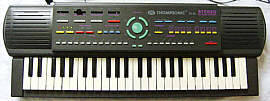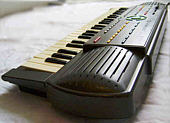|
|
This quite rare squarewave keyboard is one of the most interesting MC-3 successors, because it has real 8 note polyphony, a very simple synthesizer and permits more manual control over the sound than other keyboards based on the DSG-MC-3 sound chip. IMO it is the most professional behaving instrument in its hardware family. Also the great accompaniment has many variations, it has stereo chorus, and the base drum is analogue.
 The bizarre case style resembles rather 1950th aeroplane or soviet military
technology than a music keyboard.
The bizarre case style resembles rather 1950th aeroplane or soviet military
technology than a music keyboard. |
 |
| base | = low dull analogue drum ( =>sounds more realistic than in Letron MC-3) |
| conga | = higher squarewave blip |
| snare | = shift register noise |
| open hihat | = unique electronic metallic timbre (low-res waveform sample??, or 2 mixed squarewaves?) with truncated decay and audible end click. |
| closed hihat | = dto.' with shorter envelope |
The sounds and operation of the TS-33 behave very much like Letron MC-3, thus I will describe only the differences.
Unlike MC-3, the TS-33 has only 8 OBS preset sounds, but the so-called
"synthesizer" provides 16 sounds (including louder versions of the 8 preset
ones). Although this wannabe "synthesizer" only permits to combine 4 OBS
preset waveforms with 4 OBS preset volume envelopes (i.e. 16 sounds in
total) and thus does not deserve this term at all, it provides a nicely
intuitive realtime control by its OBS buttons, those also affect held notes.
Also the transposer and pitch buttons can be used this way. When the synthesizer
mode is enabled (by pressing the "synthesizer" button), the produced sound
is independent from the selected OBS preset sound button. Like most buttons
on this instrument, also the "synthesizer" button can be toggled in realtime
to switch held notes back and forward between the current preset and the
synthesizer sound.
 The
icons above the synthesizer "wave form" buttons are nonsense; they show
something that looks like triangular waves with different amplitudes; genuinely
these should be squarewave variants like in YM2163. The
icons above the synthesizer "wave form" buttons are nonsense; they show
something that looks like triangular waves with different amplitudes; genuinely
these should be squarewave variants like in YM2163. |
The sustain button adds a quite long release phase to the notes which makes the "piano" sound ignore key press duration. The vibrato from the vibrato button stops in the release phase of sustained notes. When sustain is switched off, all sounds stop almost immediately after releasing the key. The "stereo" button switches the stereo chorus on and off, which adds a different sort of vibrato to the sound (that doesn't stop after key release), similar like a rotary speaker simulator. But this one is not based on analogue panning like in other squarewave keyboards, but it is generated by the sound chips and also halves the polyphony, likely because it doubles all main voice notes to generate the chorus effect. Instead of panning there is only a sort of spatial stereo.
A bit strange is that pressing the "stereo" chorus button always switches off the synthesizer (despite its LED stays lit), although the synth can be re-enabled with its button while the chorus stays active. Also the normal (faster) vibrato stays disabled so long the stereo chorus is active. The synth also sporadically turns off the same way (typically after a few minutes) without any obvious reason; it might be that capacitance effects by missing pull-up resistors on the data lines from the CPU to the 2 DSGs cause data mess that in certain situations overwrites the current timbre data in internal sound chip registers and thus resets them to default, but I haven't verified this yet. Strange is also that unlike the preset sounds and rhythms, the "synthesizer" can not be enabled during the demo musics (despite it provides basically only a set of 16 preset sounds and thus does nothing complex).
The base drum of TS-33 sounds much duller and thus more realistic than
on my other DSG based keyboards, because it is made from an additional
analogue circuit. Unlike the MC-3, the 12 OBS rhythms here have each an
intro, fill-in and ending that is also accompanied by the accompaniment,
and even 2 different accompaniment styles (usually a simple and a complex
one) can be selected and toggled by the "variation" button. Similar like
with early Casio squarewave keyboards, the bass and chord voice
can be cycled through 4 timbres {piano, guitar, synth 1, synth 2} by a
button, which also works in realtime with held chord notes (synth 1 &
2 are organ tones without sustain). And thanks to its 2 DSGs this instrument
also permits reasonable main voice polyphony during accompaniment, and
the great accompaniment still permits versatile play techniques and accepts
non- chord key combinations like the MC-3. The only lacking feature in
comparison to it is the missing "manual bass" button. Also the lots of
red LEDs are gone, but instead it has the nice 4 LED metronome row that
flashes in complex patterns during rhythms.
circuit bending detailsThe Thompsonic TS-33 is based on the "SC-MC-33" CPU (software variant of MC-3DX, crystal clocked @ 1 MHz) and 2 sound ICs "DSG-MC-3".
The stereo chorus (and its LED) is activated by CPU pin 29; when pulled low (by a panel button in the keyboard matrix), it routes the analogue sound output of DSG1 to the left and DSG2 to the right stereo channel (using the 4066). The effect itself is software, halving polyphony by sending each polyphony channel simultaneously through both DSGs those are fed with phase shifted vibrato and tremolo. Strange is that the stereo chorus even activates itself (halving polyphony) when pin 29 is pulled low externally (possibly a slide switch was planned). The software support for digital pitch +/- buttons (tuning) was likely a side effect of the stereo chorus implementation, which needs pitch lookup tables for a properly detuned chorus. In mono mode, note keys are alternatingly mapped to DSG1 or DSG2. (I haven't tested how the mapping changes when it runs out of polyphony.) CPU pin 31 outputs the trigger pulse for an external analogue base drum circuit, which (like e.g. in HBATEC) is made from discrete components and easy to modify. The digital base drum of DSG1 (would share its pin with conga) is not available since it was omitted in software. Of DSG2 the audio outputs for percussion and pin 5 (OR4) are not used (stay mute). glitch noise effectsThe DSGs make musically interesting glitch noises when their select lines (CPU pins 32, 33) get shorted with each other or keyboard matrix outputs. A 1k resistor in series with a diode is sufficient to safely feed it with such random nonsense. Unlike shitshot, the sound hardware immediately continues normal work after removing the connection, so it may be used like a modulation. (I haven't permanently installed controls for it.)drumpad repairOver time the green rubber drumpads may start to respond poorly. There may be chemically incompatible materials involved those degrade the contacts over time. To fix this, the panel PCBs needs to be taken out; there are lots of loose small parts (differently coloured buttons and short rubber contact strips) underneath, so keep photos around to see which goes where. Do not mangle the brittle ribbon cables too much. Take out the green rubber drumpad circle and wash it under a watertap with mild dishwashing soap. Then clean the PCB contacts with isopropanol and cotton swabs.caution: The tiny carbon contacts of the drumpad circle are made from only a very thin layer of conductive paint (designed to fail?). Do not scrub with anything abrasive nor strong solvents on them. For cleaning, carefully touch them with a cotton swab with isopropanol, but do not wipe with excessive force. Clean contacts should work now. The drumpad circle has 2 notches and the panel 2 plastic pegs to mark the correct direction of its printed base drum icon. Put it back together and be careful not to dislodge other rubber contacts or buttons. Rest the panel rim on a raised object (case bottom) to avoid pushing buttons in when the PCB is not in place. (If random other things stop working by this, check if you damaged cables or solder joints.) keyboard matrixThe keyboard matrix layout has similarities with MC-3 and Fujitone 6a. I found no eastereggs, but here it is for comparison. The panel LEDs are multiplexed with the keyboard matrix outs. The button LEDs (except "stereo") are selected by pin 27, while the 4 tempo walking lights use pin 28.
The input lines are active-low, i.e. react on GND. Any functions can
be triggered by a non- locking switch in series to a diode from one "in"
to one "out" pin.
|
This instrument was also released as Fujitone 33, First MC-33 (only labelled "First Stereo"?), Fujiya MC-33 (seen on eBay), Passenger's MC-33 (told by e-mail) and MC-33 (by Medeli?), so the genuine name of this hardware class is "MC-33" (CPU number). With its 8 note polyphony and many changeable sound parameters this seems to be the yet most professional squarewave hardware I found among MC series keyboards (originally created by Medeli?).
Condor MC-9000 (eBay photo)
|
Another instrument of this hardware class is the large fullsize keyboard Condor MC-9000 (I asked the eBay vendor about demo melodies etc.), which has detachable speakers and was also released as Monacor MC-9000 (aka MKB-140), Trend Line MC9000, Tristar MC9000 and Kamosonic F5 (or S5?). Also a GPX version was made. eBay vendors claimed that the Trend Line version came out around 1993 and the Tristar around 1988. |
_s.jpeg)
Fujitone 6B squarewave version (eBay photo)
|
An MC-9000 variant with smaller non-detachable speakers was released as Fujitone 6B and HBATEC MC-9A (case design like Letron MC-103, button style like Letron MC-3). Regard that this model has nothing to do with the ultra-rare (later?) FM version of Fujitone 6B (aka MC-6B, see here) that contains the same hardware like Fujitone 6A. |
| removal of these screws voids warranty... | ||
 |
||
|
|